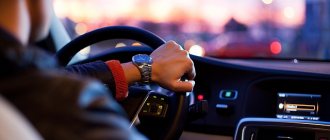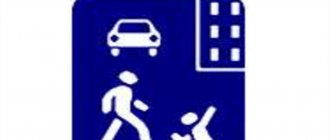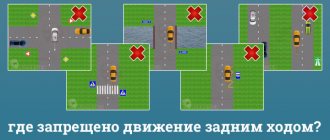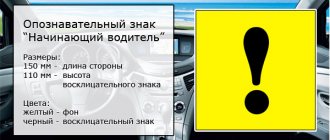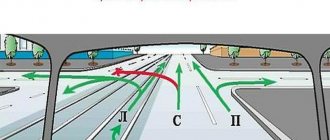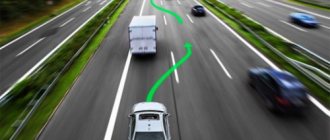Drivers' responsibilities
1. The driver of a mechanical vehicle must have with him, and at the request of police officers, hand over to them for inspection:
Driver's license
- a driver's license of the category that corresponds to the category of the vehicle. Vehicles of category A include motorcycles, and vehicles of category B include cars and trucks with a permissible maximum weight of no more than 3.5 tons, in which the number of passenger seats provided for by design is no more than eight;
- registration documents (registration certificate) for the vehicle, and if there is a trailer, also for the trailer;
- insurance policy of compulsory motor third party liability insurance (MTPL);
- in specially specified cases - other documents provided for by the Rules.
Fasten your seat belt
2. When driving a vehicle, be wearing a seat belt and ensure that passengers, including those riding in the rear seats of a car, also wear their seat belts.
When driving a motorcycle, wear a fastened motorcycle helmet and do not carry passengers without a fastened motorcycle helmet.
3. Before leaving, check and ensure that your vehicle is in good technical condition on the way.
4. At the request of police officers, undergo an examination for intoxication, which can be carried out at the place of the stop or in a drug laboratory.
5. Provide your vehicle in cases provided for by law:
- police officers;
- employees of federal state security agencies;
- FSB employees;
- medical and pharmaceutical workers to transport citizens to the nearest medical facility in cases that threaten their lives.
The right to stop a vehicle is granted to traffic controllers. Persons who have the right to stop a vehicle are required to present a service ID or license plate upon the driver’s request.
How are “passengers” and “pedestrians” defined in traffic regulations?
If you were trained at a driving school, then you will easily remember that the teachers said that in an emergency situation with a pedestrian, in the vast majority of cases the driver is to blame. In fact, this is not the case, and teachers use this technique as a preventive measure. The driver is warned in advance, which means he will be more careful on the road
According to traffic rules, a pedestrian has no advantages over a driver. Moreover, it is often the pedestrian road user who initiates an emergency situation. If we turn to the terms, then the traffic rules have a clear interpretation and description for each road user, namely:
- “pedestrian” is a person who is not inside a vehicle and does not perform work duties on the roadway. Pedestrians may include a disabled citizen moving in a special wheelchair, a cyclist or motorcyclist driving a vehicle, a person pulling a sleigh, cart, or baby stroller;
- “passenger” is a participant in the movement who is subject to certain responsibilities. He is located inside a vehicle (on a motorcycle), but does not control the vehicle.
There is a small nuance, which is also described in the rules. When a person rides a bike, it means that he is guided by the rules for the driver, and if he is driving a bicycle, then he must follow the rules for the pedestrian.
The driver is prohibited
Driving a vehicle while intoxicated
- drive a vehicle in a state of alcohol, drugs or other intoxication, under the influence of medications that impair attention and slow reaction, in a painful or tired state that jeopardizes traffic safety;
- transfer control to persons in such a state;
- use intoxicating substances between the commission of an accident and the passage of an examination for intoxication, or between a stop for the purpose of conducting an examination and its implementation;
- transfer control to persons who do not have a driver’s license or are not included in the MTPL insurance policy;
- cross organized transport and foot columns and take place in them;
- drive a vehicle in violation of the work and rest schedule;
- use while driving a telephone that is not equipped with a “hand-free” technical device that allows you to negotiate without using your hands.
Signs
The rules of the road (it's best to learn them and be safe) are something that every person should learn. Even the one who believes that he will never have to drive a car. This is a topic that everyone needs to learn, like the alphabet or the multiplication table. Well, or if you don’t memorize the whole book, then at least you need to learn the signs.
Basically, people need to know where they are allowed to cross the road. Pedestrian crossing sign - it would seem, what could be simpler? But there is one nuance that may surprise many. Some people, encountering a warning “triangle” in a red frame, which depicts a person moving along a “zebra crossing,” believe that it is here, in this place, that they can cross the road. No! This sign only warns that in 50-100 meters there will be a pedestrian crossing. It's important to remember this! The sign that indicates the place where it is allowed to cross the roadway is a blue rectangle.
Driver's actions in case of an accident
In case of a traffic accident with injured or killed, the driver involved in it is obliged to:
Put up a warning triangle
- Stop immediately, turn on your hazard lights and display a warning triangle. Do not move objects related to the incident.
- Call an ambulance or rescuers (from a mobile phone - call 112). Before their arrival, provide first aid to the victims. In exceptional cases, it is allowed to send the victims to the nearest medical facility in a passing vehicle or in their own vehicle. In the latter case, after delivering the victim to the hospital, the participant in the accident is obliged to return to the scene of the accident.
- Report the incident to the police (from a mobile phone - call 112). Write down the names and addresses of eyewitnesses and wait for the police to arrive. The roadway can only be cleared upon command from the police. However, if the movement of other vehicles is impossible, then the driver must record in the presence of witnesses all traces and objects related to the incident and organize a detour around them. After this, you can clear the roadway.
- Notify your insurance company about the accident. After registering an accident, police officers, together with other participants in the incident, fill out a Notice of Road Accident. Subsequently, the completed notice is submitted to the insurance company along with documents prepared by the police:
- a copy of the accident certificate;
- a copy of the protocol on the administrative offense;
- a copy of the resolution in the case of an administrative offense.
Major violations of pedestrians and passengers
Everyone is obliged to follow the rules, since this allows them to avoid emergency situations, however, violations do happen quite often. As an example, let's look at the most common violations.
| Major violations by pedestrians | Failure to comply with rules by passengers |
|
|
Even if a violation has occurred, the guilt of the passenger, pedestrian or driver must be proven. Before the law, these traffic participants have equal rights, and also, each assumes certain responsibilities.
Road accident without injuries
Road accident without injuries
In case of an accident without injuries, steps 1, 3 and 4 must be followed. Before the police arrive, you should carefully inspect the scene of the accident and the damage to your vehicle.
The information you collect can be very useful when filing an accident.
If there are no victims in an accident and there are no disagreements between its participants, then instead of calling the traffic police, it is allowed to independently come to the nearest traffic police post or police department with a road accident diagram drawn up and signed by both participants.
Since the road accident diagram is evidence in a traffic accident case, you can sign it only after making sure that everything depicted on the diagram corresponds to reality.
If only two vehicles are involved in an accident without casualties, the owners of which have valid MTPL policies, and there are no disagreements about the circumstances of the incident and the nature of the damage caused, it is permissible not to involve police officers in registering the incident, but to confine oneself to filling out an Accident Notice so that the insurance company compensates the victim harm caused.
At the same time, the victim must keep in mind that with a simplified registration procedure, the maximum possible amount of compensation is 25 thousand rubles. If the preliminary assessment of the damage caused exceeds this amount, it is necessary to register an accident with the involvement of traffic police officers.
What responsibility do pedestrians and passengers bear for violations?
There is a penalty for each road user. According to the law, we are talking about penalties and more serious measures. In particular, for identifying violations, passengers and pedestrians are fined 500 rubles. If such actions lead to traffic obstruction, the amount increases to 1000 rubles.
When light or moderate harm was caused to the health of other people, the fine will be 1000-1500 rubles. Criminal liability is also provided for grievous harm to the health of another person, for death and for the death of two or more citizens. The term of imprisonment can be 3-7 years.
Passenger Responsibilities
1. Passengers are obliged to:
- when traveling in a vehicle, wear seat belts, and when riding a motorcycle, wear a fastened motorcycle helmet;
- boarding and disembarking from the car should be done from the sidewalk or curb and only after a complete stop. Boarding and disembarking from the side of the roadway is permitted provided that it is safe for the passenger and does not interfere with other road users.
2. Passengers are prohibited from:
- distract the driver while driving;
- when traveling on a truck with a flatbed, stand, sit on the sides or on a load above the sides;
- open the doors of the vehicle while it is moving.
The rules prescribed in the traffic rules
The main document that road users must follow is the “Rules of the Road”. It does not have the status of law. But the demands he puts forward are mandatory. The traffic rules describe in detail what traffic participants should do for the sake of everyone’s safety, and what they are prohibited from doing.
For drivers
A person driving a vehicle bears great responsibility not only for his own life and health, but also for other people. Therefore, in the traffic rules, the responsibilities of passengers, pedestrians and drivers are divided and specified. For the last category of traffic participants, section 2 of the legal document is especially important, which requires:
- have with you and present to the traffic police officer, upon his instructions, the right to drive a vehicle, STS, as well as documents permitting certain types of activities (if he is a taxi driver, transporting cargo);
- Before driving, fasten your seat belt and ensure that passengers use it;
- the motorcyclist is obliged to wear a helmet and make sure that the protective device is on the one he is carrying;
- monitor the serviceability of your car, provide it for professional diagnostics and repairs on time;
- drive in a sober, adequate state, and, at the request of a traffic police officer, undergo an alcohol test and a medical examination;
- provide your vehicle to emergency services personnel if required by law and the current situation;
- stay at the scene of an accident when you become involved in it and can do without being sent to the hospital;
- provide medical assistance to accident victims;
- follow the traffic order prescribed by signs and markings;
- do not forget about the priority of other vehicles, if it is established by the rules.
If a motorist or motorcyclist fails to perform any of their duties, causing an accident, they are usually held liable, not the pedestrian or passenger. Most of the articles of the Code of Administrative Offenses for violating traffic rules also apply to drivers.
For pedestrians
Those who travel on roads not in transport also bear their share of responsibility for road safety. Therefore, responsibilities also exist for pedestrians:
- walk in designated areas (sidewalks, special paths, left side of the curb);
- in the absence of this opportunity, it is allowed to move onto the roadway, but walk along it with caution, towards oncoming transport (people in wheelchairs - in the same direction as it);
- if you have to walk across the road in the dark, with poor visibility, or use the side of the road, the edge of the road, you should wear reflective devices;
- if necessary, cross the roadway, do so at a pedestrian crossing;
- if it is not there, they move to the other side at right angles to the road in a place where the person is clearly visible to drivers;
- comply with the requirements of traffic controllers and traffic lights;
- before entering a zebra crossing where there is no traffic light, assess the distance to approaching cars and do not rush;
- You cannot stop or linger on the roadway without a good reason;
- those who do not have time to reach the sidewalk at a green traffic light must wait for the next one on the median line of the roadway, where no cars are driving;
- In all cases, special services vehicles moving with a siren and a lit flashing light should be allowed through;
- wait for buses or taxis at specially designated areas.
When walking along the sidewalk with a child, it is better for an adult to be on the side of the roadway. You should always move on the right side of the sidewalk or zebra crossing, slowly, but not too slowly.
Within the boundaries of residential areas and courtyards adjacent to houses, pedestrians also have priority. But here too they must be guided by rule 17.1:
In a residential area, that is, in an area whose entrances and exits are indicated by signs 5.21 and 5.22, pedestrian movement is permitted both on sidewalks and on the roadway. In residential areas, pedestrians have the right of way, but they must not unreasonably interfere with vehicular traffic.
For passengers
People who use transport other than as drivers should also contribute to traffic safety. The rules and responsibilities of pedestrians and passengers have much in common. But for the second category there are special requirements:
- they must use seat belts if the seat is equipped with a device;
- During the trip, the passenger must behave in such a way that the driver can calmly, without interference, drive the car;
- if it is impossible to exit the vehicle from the sidewalk, you must leave the vehicle so as not to create a threat to other people and the traffic as a whole;
- If a passenger is riding on a flatbed truck, they must not sit or stand on the sides or cargo that is higher than them;
- You cannot open the car door while it is driving.
In some cases, the driver of the vehicle has to pay for the offenses committed by the passenger.
Responsibilities of pedestrians
- Pedestrians must walk on sidewalks, verges or footpaths. In the absence of sidewalks, pedestrian paths and roadsides, pedestrians can move in one row along the edge of the roadway towards the movement of vehicles.
- Pedestrians must cross the roadway at pedestrian crossings, and if there are none, at intersections along a line that continues the line of the sidewalk or curb. At unregulated pedestrian crossings and intersections, pedestrians can enter the roadway only after assessing the distance to approaching vehicles and their speed, and making sure that crossing the road will be safe for them. If there is no crossing or intersection in the visibility zone, it is allowed to cross the road strictly across the roadway, provided that the road section does not have a dividing strip or fences and is clearly visible in both directions.
- In places where traffic is regulated, pedestrians must follow the signals of the traffic light or traffic controller.
- If a vehicle with special signals (blue flashing light and siren) is approaching the place where a pedestrian is crossing the road, then the pedestrian must refrain from crossing. A pedestrian who is already on the roadway at this moment must immediately clear it without interfering with a special vehicle.
- Waiting for a tram, trolleybus, bus, minibus and regular taxi is allowed only on landing platforms, and in their absence - on the sidewalk or on the side of the road. It is permitted to enter the roadway to board a vehicle only after it has stopped (this requirement also applies to boarding a tram that has stopped in the middle of the roadway).
Traffic rules for pedestrians
In driving schools, when considering situations involving pedestrians, drivers are directed to ensure that the latter are right.
This is a preventive measure and a good warning. According to the rules, a pedestrian does not have priority over vehicles. Traffic regulations give a clear interpretation of the term “pedestrian”. This is a person who is outside of transport and not working on the roadway. A pedestrian includes a person moving in a wheelchair, driving a bicycle, motorcycle, pulling a sled, cart, baby stroller or wheelchair.”
The definition clearly delineates entities that may have a dual role. The rules are clear:
- if you ride a bicycle, you obey the rules for the driver;
- If you drive a bicycle, you obey the rules for a pedestrian.
Major traffic violations by pedestrians
1. Violation of markings and signs
Everyone must know the definition of a pedestrian crossing. It is defined as a part of the road that is marked with signs and (or) markings and is designated for the movement of pedestrians. If there is no marking, the width of the transitions is set by the distance between the signs.
Depending on the situation, the transition is indicated differently:
- markings and signs;
- one marking;
- just signs.
2. Ignorance of the rules
The “Give Way” requirement means that a pedestrian cannot start, resume, continue moving, or perform maneuvers if these actions interfere with other road users who have priority over him. Most people do not know this requirement and the fact that traffic police officers in each specific situation may interpret it differently.
It must be remembered that the driver, pedestrian, passenger are equal participants in the movement. They have their own rights, duties and responsibilities.
Responsibilities of pedestrians traffic rules
The responsibilities of a pedestrian of the traffic rules are stated in chapter 4 and paragraphs of rules 4.3;
4.5 and 17.1. Chapter 4 of the Traffic Regulations for Pedestrians explains their responsibilities . It is necessary to know the points at which vehicular traffic intersects with pedestrian traffic and a question of dominance may arise.
Clause 4.3. defines the rules of a pedestrian, where he is obliged to move across the road :
- along a pedestrian crossing (underground and overground);
- if there are no crossings, then at intersections;
- if there is no crossing or intersection, then it is possible to cross the road perpendicular to the roadway.
It is worth remembering that crossing a road other than a crossing is an exception. You need to cross the road only at the pedestrian crossing.
Clause 4.5 determines the correct movement along an unregulated crossing . You can go out on the road only after assessing the distance to moving cars. You need to roughly estimate their speed and make sure that you can cross safely.
It must be remembered that when moving outside pedestrian crossings, a person should not interfere with transport. It is prohibited to get out from behind a stationary vehicle or other obstacle unless you are sure that there are no moving cars.
There are two important points to remember:
- own safety is the responsibility of the pedestrian;
- When moving outside the crossing, a pedestrian has no advantage over vehicles.
Clause 17.1 determines the movement of pedestrians in the residential area and courtyard areas . Pedestrians are allowed to move on sidewalks and roadways if they do not create unreasonable interference with traffic. In a residential area, pedestrians have advantages over vehicles
Responsibility for violation of traffic rules by pedestrians
According to the law, a pedestrian is responsible for violating traffic rules.
The liability of pedestrians is regulated by sections 4 and 5 of the Russian Traffic Regulations. Administrative responsibility of a pedestrian:
- traffic violations are subject to a fine of 500 rubles;
- violations that result in interference with the movement of vehicles are punishable by a fine of 1,000 rubles;
- Violations resulting in mild or moderate harm to the health of the victim are punishable by a fine of 1,000 to 1,500 rubles.
Criminal liability of a pedestrian:
- If the violations lead to serious harm to health, the perpetrator may be subject to criminal liability for up to 3 years.
- If the violations lead to the death of the victim, the perpetrator may be subject to criminal liability for up to 4 years.
- If violations result in the death of two or more people, the perpetrator may be subject to criminal liability for up to 7 years.
Also, after assessing the damage, liability regulated by the Civil Code may arise:
The pedestrian is liable for damage to property, health, and moral harm, including to the owners of cars, motorcycles and other vehicles.
Video: Responsibilities of a pedestrian Traffic Regulations of the Russian Federation

